Play Strategy Action 6.3 Play in the Home
A study of information, messages
and resources available to parents
and carers in Scotland for cost
effective play in the home.
Summary of Main Findings
Objective 1: Discover and quantify all available and information or messages available to parents and carers on cost-effective resources for play in the home environment
During the field work over 300 resources from 134[7] different organisations were reviewed. Of these sources 166 were deemed as within scope of this study.
These sources captured a wide range of advice and activity information for a variety of family groups with different needs and are delivered across a wide variety of mediums. The full list of resources can be found in Appendix B which is available on request.
Objective 2: Analyse, Assess and Segment the information and messages by
2.1: Effectiveness of reach (current reach and potential reach)
Without having access to the analytical data of each organisation or by surveying a large sample of parents and carers it is not possible to accurately give details on the effectiveness of the reach of the materials. That said some observations can be made on a both a local and national level:
- Of the 166 resources found 76 are delivered nationally whilst 90 are delivered locally.
- Of the 76 national services some aim to be delivered to every family in Scotland such as the play@home series of books. This is the only resource that has the potential to reach to all parents with young children.
- The Play Talk Read Roadshow and service is another example of an excellent resource at a national level that it using both online and offline resources to reach as many parents as possible.
- Larger local authorities and those based around large cities offer slightly more services than those in more rural locations, with the exception of Glasgow. However there appears to be no direct correlation between population sizes and the number of resources available.
| Region served by resource (as stated by resource) | Number of resources for that region | Estimated population figures for region[8] |
|---|---|---|
| All Scotland | 76 | 5,222,100 |
| Aberdeenshire | 1 | 245,780 |
| Bo'ness | 1 | 14,490 |
| Borders | 3 | 112,870 |
| Clackmannanshire | 3 | 50,630 |
| Clyde and West Dunbartonshire | 1 | 170,340 |
| Dundee | 8 | 144,290 |
| East Ayrshire | 1 | 120,246 |
| East Lothian | 2 | 97,500 |
| East Renfrewshire | 3 | 89,540 |
| Edinburgh | 30 | 486,120 |
| Edinburgh and Dunfermline | 1 | 535,120 |
| Fife | 2 | 365,020 |
| Fife and Dundee | 13 | 509,310 |
| Glasgow | 5 | 592,820 |
| Glasgow and South Lanarkshire | 1 | 904,700 |
| Highlands and Moray | 1 | 309,350 |
| Kirkintilloch, Bearsden and Twechar | 1 | Not available |
| Midlothian | 1 | 81,140 |
| Perth | 1 | 44,000 |
| Perth and Kinross | 2 | 147,780 |
| Renfrewshire | 1 | 170,250 |
| Tayside | 1 | 391,680 |
| West Dunbartonshire and East Dunbartonshire | 1 | 195,150 |
| West Lothian | 1 | 172,080 |
| Western Isles | 1 | 26,502 |
| Inverness | 1 | 72,000 |
The majority of resources found were online and therefore require access to a computer and the Internet. Whilst digital inclusion is currently improving across Scotland it must be noted that access to this information offline is still vitally important to service vulnerable segments of society. The Play Talk Read Roadshow and service is an example of an excellent resource at a national level that is using both online and offline resources to reach as many parents as possible.
With the exception of the videos on Parentchannel.tv the majority of resources require an intermediate level of reading for the parent or carer to assess and utilise the resource. With an estimated 26.7% of adults across Scotland experiencing some difficulty in reading and 3.6% having very poor reading skills the emphasis on using text based resources results in excluding this segment of society. This is evidenced in the NHS Review[9] of play@home books where it was stated on multiple times that some parents found the books 'too wordy' and complex to take in.
It should however be noted that resources are often delivered face to face via a playgroup, health worker or support worker or handed out at the end of a session such as the activities cards delivered by SPPA. Resources such as this were only captured by the study if they were easy to find online and so may not be fully represented in these findings.
2.2: Target age group
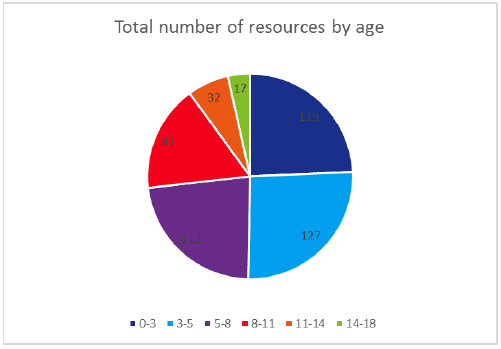
The study revealed that there are roughly the same number of resources available for parents and carers of children under the age of 5 as to all other age groups. This shows the significant skew to producing advice and activities for this age range. This does not seem to differ depending on the type of advice offered (e.g activity, advice or both).
Children between the ages of 14 and 18 are particularly poorly catered for, with the majority of information to parents and carers for this age group focused on advice for dealing with negative behaviour (such as bullying, substance abuse, sexual health etc) rather than positive messages for interacting with this age group. As it was expected that there would be low volumes of literature found with this group due to the word 'play' it was searched for under any interaction with a teenager in the home. There were high volumes of information available directly to young people in this age group such a Young Scot but this was deemed out of scope as it was not encouraging interaction within the home environment or with a parent or carer and was mainly focused on being outside of the home and without a parent or carer.
The work that is done by befrienders at Children 1st should be noted as a good example of work regarding play for these older children (up to 16).
2.3: Inclusivity
2.3.1: Clarity and Accessibility of information
In general the clarity and accessibility of the language used was excellent. That said with an estimated 3.6% of the Scottish Population having very poor reading skills the resources, with the exception of the videos, are largely unsuited for this section of society.
In addition there was feedback for the play@home books suggesting that there was too much information contained within them and some of the language was complex - indicating the need to use design and language that is as inclusive as possible.
When the resources were subjectively reviewed 148 out of 166 were rated as being excellent in terms of clarity and accessibility of language, 17 were rated as above average and 2 were rated as average. This shows that there is currently a high standard of clarity and accessibility across all regions, ages and activity types.
It should be noted that there is a lack of consistency within the messaging for national services and resources across the different regions. Some are positioned locally and some nationally with different offerings at different levels. This can be confusing as to which resources and information are applicable and relevant to parents.
A good example of when this is done well is the Play Talk Read website that uses design, language and imagery to effectively communicate its messages and create an engaging experience.
When reviewing the languages and accessibility options (large print, braille, spoken word etc) available it was noted when an alternative version was offered. All the resources were available in English, 7 were offered in different languages and 16 offered accessible versions:
| Option availability | Number of Resources |
|---|---|
| English Only | 159 |
| Gaelic | 4 |
| Polish | 4 |
| Others | 1 |
| Accessible versions | 16 |
It was noted however in the Children 1st report to the Scottish Government[10] that the majority of resources and services are available in multiple languages and accessibility options but are not listed as available.
2.3.2: Cost to parent for resource
Of the 166 resources reviewed 162 of them were free to access for parents and carers.
The 4 that were paid for resources were all toy libraries with different fees for membership to the library, each with different membership agreements:
| Toy Library |
Fees |
|---|---|
| Kirkton Toy Library |
£1 per annum to join |
| Perth Toy Library |
£5 per annum to join and a fee of £0.50 -£2.50 per toy OR |
| Play Borders Toy Library |
£20 per annum to join |
| Play Plus Edinburgh toy library for under 5s |
£6 per annum to join |
This shows that there is a multitude of free and cost effective resources for parents and carers available.
2.3.3: Cost to parent or carer for activity
112 of the resources reviewed were deemed as free for the parent or carer to engage in the activity, of which 110 of them had no cost to the parent or carer to access the activity or resource and so have £0.00 cost to the parent.
The remaining 54 resources had a cost assigned to them as between £0.00 - £4.99. This was as the majority of activities were using household items and food items that are found in the home environment and are relatively cost effective to replace.
It should be noted that the cost of travel was not taken into account as part of this study. This is as the study was based in the home area however some of the workshops, interactive group sessions and participative play sessions require travel to a venue and this should be taken into account.
Additionally the cost of access to the internet was not taken into account as it is accessible for free from most libraries, however the cost of printing a resource (e.g. a dot-to-dot) was.
2.3.4: Ability of child to participate in activity
It should be noted that the review of the ability of a child to participate in an activity is subjective and difficult as each child is an individual with individual needs. Therefore a simple system as outlined below was used:
| Ability level | Description | Number of Resources Available |
|---|---|---|
| Low | All children can participate and activity can be largely adapted for children with additional support needs | 146 |
| Low-medium | Most children can participate but the activity is not largely transferable for children with additional support needs | 3 |
| Low- physical | Children with full physical capabilities are able to participate | 1 |
| Medium | Requires medium level of coordination and physical ability | 1 |
| Additional Support Needs | Specially developed for children with additional support needs | 3 |
| n/a | Ability of child is not applicable to the resources (advice only) | 12 |
The majority of resources found could be used for all children and can be easily adapted to the child's individual stage of development.
It should be also noted that there were a large number of support services and organisations who work with parents and carers of children with additional support needs that used play as a technique for interaction and communication. However these organisations were largely deemed out of scope of this study as they did not state that they specifically support play in the home for these children even though the skills are largely transferrable.
2.4: Sectors producing this information
Due to the time limitations of this study it was decided to limit the fieldwork to public and third sector organisations.
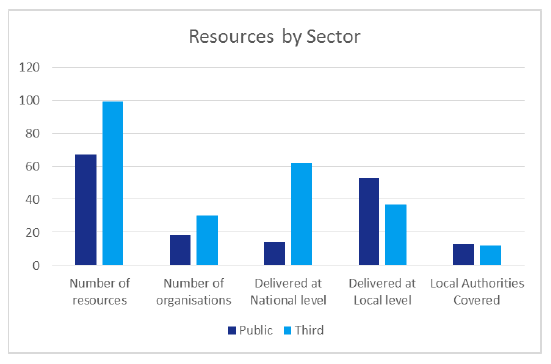
There are 67 public sector resources from 18 organisations in Scotland delivering this information and messaging at both a local (53 sources across 13 Local Authority Areas) and national level (14).
There are 99 resources from 30 Third Sector organisations in Scotland delivering information and messaging at both a local (37 resources across 12 Local Authority Areas) and national level (62).
In general there was good cross-messaging between Third and Public Sector Organisations and clear signs of collaboration. There were however great disparities between the level, volume and type of information given from similar public organisations. For example The City of Edinburgh Council have a variety of information on their website for parents and carers including activity cards, yet 14 other councils had no information at all on their website regarding the subject or where to get information from.
It should also be noted that there are wide variety of Other Sector Organisations who are producing extremely good information and messaging on play in the home. As these were deemed out of scope they have not been included however some that should be noted as good examples of best practice:
Cbeebies
Mumsnet
Netmums
Familyfun.go.com (Disney)
In addition to this there are wide range of books on the matter that are available to purchase or to borrow from the library that were not included in this study.
2.5: Media type
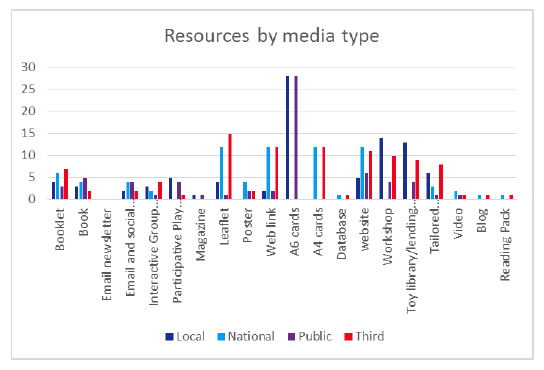
It can be seen that a wide variety of media is used to convey the messaging to parents and carers, irrespective of whether this is on a national or local level or who produced the material.
Leaflets and A4/A6 Activity cards are the most popular choice of media most likely due to their low production costs and their style supports consumption of information. However information delivered like this is often disposable and so lasting media such as the books and websites should be used for resources that can be used multiple times.
2.6: Information type (Advice, Activity or both)
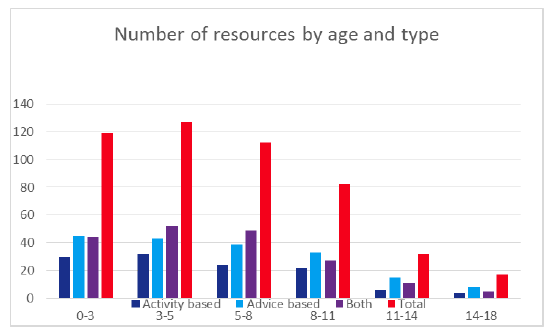
There was a relatively good split between advice and activity based information across all the age groups, with advice always slightly higher in volume than activity. This is most likely due to the information being targeted at parents and carers and therefore is aligned to what they are looking for.
2.7: Geographical reach
As there were 76 resources delivered at a national level it can be argued that all of Scotland has access to cost effective resources to play. However when looking at how resources and services are delivered at a local level it can be seen that some local authority areas are serviced better than most with 14 local authorities areas with no resources found on a local level when looking at the volume of resources, the resources delivered to age group and family type:
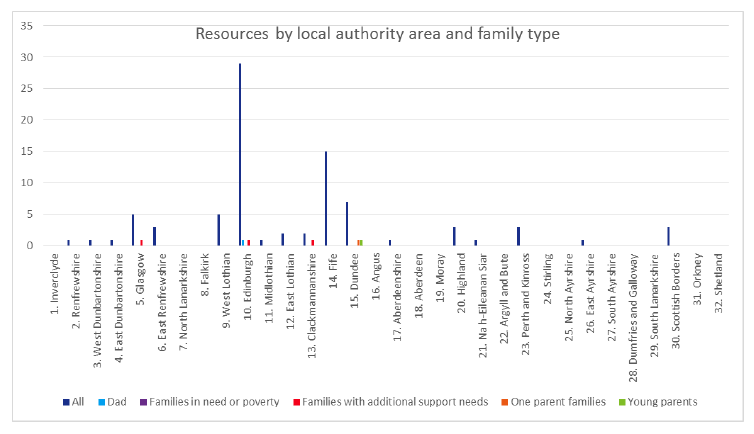
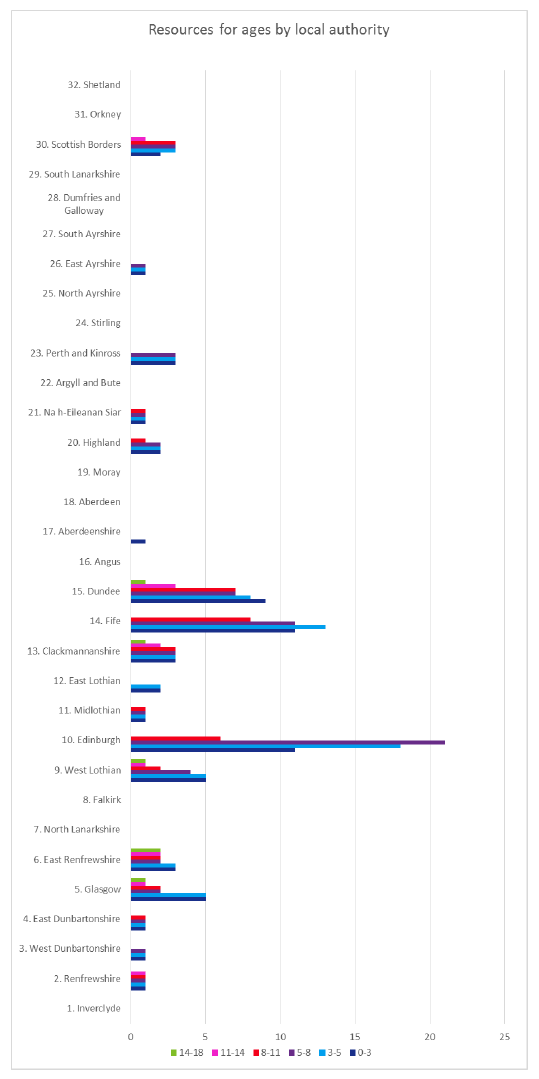
- Edinburgh Fife and Dundee led the way in terms of delivering volumes of information
- No area serves the 11-18 year old well
- Most resources on a local level are not targeted to individual family types but to all types
- Rural and isolated regions tend to be less well served than urban regions.
2.8: Population Segment and family type
Without directly surveying the parents and carers who utilise these resources and services it is not possible to determine the usage by generic population segments. Therefore the materials were assessed by whom they were targeting the resource, activity or service to.
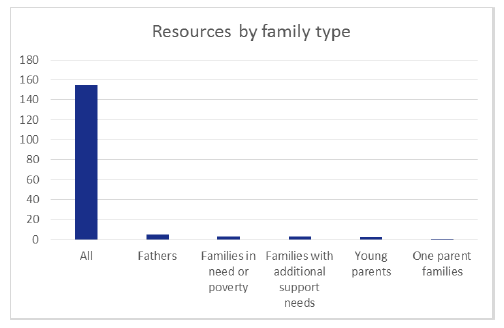
This shows that the literature and messaging delivered is generic in nature to family type.
Whilst this universal approach is good as the majority of information is transferrable to any family type it may lead to alienation of certain family types such as kinship families or one parent families. That said there is evidence that the most vulnerable of families that are not being served by these resources and messaging are more likely to have a support worker through either a public or third sector organisations to help them identify resources, services and activities.
Objective 3: To identify where there is duplication of materials
Whilst there was some duplication of messaging and information across the resources in the study (e.g. recipe for play dough appears frequently across activity cards etc). There were only 5 incidences of duplication found.
It should be noted that not all incidences of duplication are negative as if the information is relevant and useful it should be shared as often as possible to maximise reach.
Objective 4: To conduct gap analysis to identify:
4.1: Parent and carer segments not being served
The fieldwork revealed that there are no resources of this nature targeted directly to kinship families and other non-standard family types may not be receiving a large amount of specific information targeted to them. That said the majority of the information in the resources are transferrable irrespective of family type.
In addition to this families who require additional support needs are often helped by either a support or health work to uncover the resource and information to hand and utilise it. It would however be prudent to produce more resources that are reflective of the different family types as opposed to the standard unit.
4.2: Play types not covered
All types of play were covered either as an individual resource or most types of resource contained information on multiple types of play. That said the definitions of play type did not seem to match the commonly used terms in the resources e.g. risky play, messy play.
4.3: Groups of young people not served
The main group of young people not being served is the 14-18 year old group. This age group is generally encouraged to participate in fun/play activities outside of the home with their peer group such as Young Scot. Whilst this is understandable and should be continued there was a clear deficit of information available to parents and carers who want to interact positively with their teenagers.
By reviewing the literature it was clear that the messaging to parents changes around the age of 11 from encouraging free play to structured play and dealing with negative behaviour and post 14 the majority of information is regarding substance abuse, sexual health and bullying - not fun.
4.4: Types of media not created
Due to the study constraints there was a heavy skew to reviewing online assets. However it was noted that there was a limited usage of video and sound for information, messaging and activities. This media is vital to delivering messages and information to the members of the population with reading difficulties.
4.5: Key sectors not producing this information
Due to the limitations of the study only two sectors were looked at. However 14 councils who do not produce any relevant, findable information were identified:
Inverclyde
Angus
Aberdeen
Moray
Argyll and Bute
North Lanarkshire
Stirling
North Ayrshire
South Ayrshire
Dumfries and Galloway
Falkirk
South Lanarkshire
Orkney
Shetland
4.6: Geo-locations that are not being served
As above the 14 councils areas identified as not delivering messages at a local level are indicators that these areas are not being served. In addition to this the rural and isolated areas such as the Highlands and Islands are not being served as well as the more urban areas of Edinburgh, Fife and Dundee.
It should be noted that not all resources were captured during this study, only those that are easily available or discussed online. There are many organisations who are delivering this information on a local level either in groups or in a face to face capacity.
Objective 5: Develop Recommendations to support the aims: 1) "Develop user friendly guidance on how to access cost effective resources of play" and 2) "That Scotland will be the best place to grow up"
- Reduce the fragmentation of resources and information by producing a portal that acts as the 'go to' place to find information for all ages and locations.
- Stop treating teenagers as problems and send out more positive messages for parents to be able to interact with them in a fun and non-purposeful way.
- Encourage organisations to produce accessible versions of their resources and materials and where applicable in multiple languages. Where these are already available ensure that organisations clearly state where they can be obtained from.
- Produce more materials in video and audio format in order to reach parents and carers with reading and sight difficulties.
- Create more resources for children over the age of 5 as all these age groups are not as well serviced, in particular ages 14-18.
- Ensure that resources that are delivered on both a local and national level are consistent in message and tone.
- Add in potential activity adaption options to suit the varied abilities of children.
- Encourage a consistency for the type and level of basic information available across councils and health boards so that all of Scotland is reached.
- Ensure that all content is web optimised and can be adapted to keep pace with the changing technologies and needs of parents and carers.
- Survey parents and carers to gain their opinions on the quality, relevance and availability of materials.
Recommendations for further research
Organisations Identified but not reviewed:
ELCAP
Deaf Children's Society
Hands On Scotland
Homelink
Epilepsy Scotland
Contact a family
Deaf Action Scotland
Pink Parents
The Butterfly Trust
Down's Syndrome Scotland
SCCYP
Contact
Email: Dave Gorman
There is a problem
Thanks for your feedback